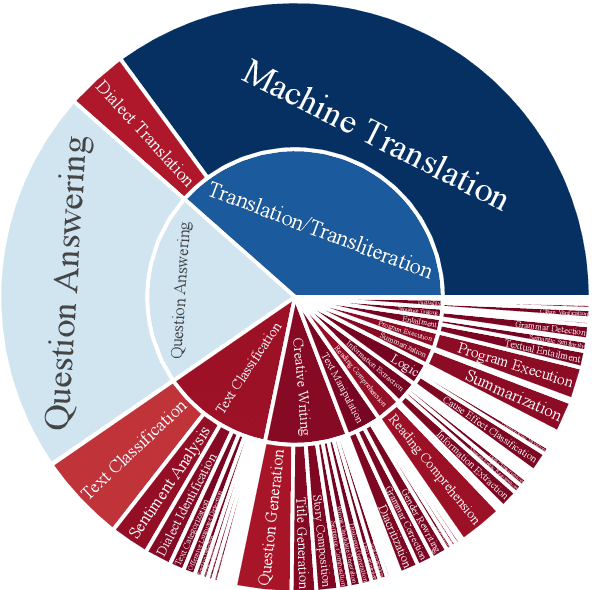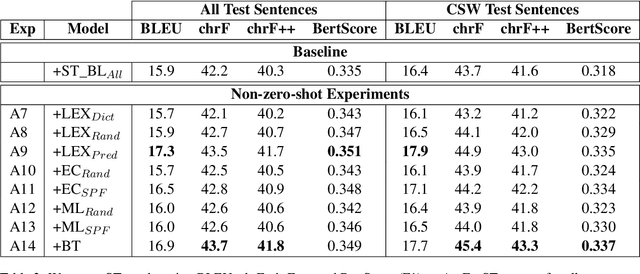Nizar Habash
New York University Abu Dhabi
Data Augmentation for Maltese NLP using Transliterated and Machine Translated Arabic Data
Sep 16, 2025Abstract:Maltese is a unique Semitic language that has evolved under extensive influence from Romance and Germanic languages, particularly Italian and English. Despite its Semitic roots, its orthography is based on the Latin script, creating a gap between it and its closest linguistic relatives in Arabic. In this paper, we explore whether Arabic-language resources can support Maltese natural language processing (NLP) through cross-lingual augmentation techniques. We investigate multiple strategies for aligning Arabic textual data with Maltese, including various transliteration schemes and machine translation (MT) approaches. As part of this, we also introduce novel transliteration systems that better represent Maltese orthography. We evaluate the impact of these augmentations on monolingual and mutlilingual models and demonstrate that Arabic-based augmentation can significantly benefit Maltese NLP tasks.
AraHealthQA 2025: The First Shared Task on Arabic Health Question Answering
Aug 28, 2025Abstract:We introduce {AraHealthQA 2025}, the {Comprehensive Arabic Health Question Answering Shared Task}, held in conjunction with {ArabicNLP 2025} (co-located with EMNLP 2025). This shared task addresses the paucity of high-quality Arabic medical QA resources by offering two complementary tracks: {MentalQA}, focusing on Arabic mental health Q\&A (e.g., anxiety, depression, stigma reduction), and {MedArabiQ}, covering broader medical domains such as internal medicine, pediatrics, and clinical decision making. Each track comprises multiple subtasks, evaluation datasets, and standardized metrics, facilitating fair benchmarking. The task was structured to promote modeling under realistic, multilingual, and culturally nuanced healthcare contexts. We outline the dataset creation, task design and evaluation framework, participation statistics, baseline systems, and summarize the overall outcomes. We conclude with reflections on the performance trends observed and prospects for future iterations in Arabic health QA.
The Arabic Generality Score: Another Dimension of Modeling Arabic Dialectness
Aug 24, 2025Abstract:Arabic dialects form a diverse continuum, yet NLP models often treat them as discrete categories. Recent work addresses this issue by modeling dialectness as a continuous variable, notably through the Arabic Level of Dialectness (ALDi). However, ALDi reduces complex variation to a single dimension. We propose a complementary measure: the Arabic Generality Score (AGS), which quantifies how widely a word is used across dialects. We introduce a pipeline that combines word alignment, etymology-aware edit distance, and smoothing to annotate a parallel corpus with word-level AGS. A regression model is then trained to predict AGS in context. Our approach outperforms strong baselines, including state-of-the-art dialect ID systems, on a multi-dialect benchmark. AGS offers a scalable, linguistically grounded way to model lexical generality, enriching representations of Arabic dialectness.
BALSAM: A Platform for Benchmarking Arabic Large Language Models
Jul 30, 2025



Abstract:The impressive advancement of Large Language Models (LLMs) in English has not been matched across all languages. In particular, LLM performance in Arabic lags behind, due to data scarcity, linguistic diversity of Arabic and its dialects, morphological complexity, etc. Progress is further hindered by the quality of Arabic benchmarks, which typically rely on static, publicly available data, lack comprehensive task coverage, or do not provide dedicated platforms with blind test sets. This makes it challenging to measure actual progress and to mitigate data contamination. Here, we aim to bridge these gaps. In particular, we introduce BALSAM, a comprehensive, community-driven benchmark aimed at advancing Arabic LLM development and evaluation. It includes 78 NLP tasks from 14 broad categories, with 52K examples divided into 37K test and 15K development, and a centralized, transparent platform for blind evaluation. We envision BALSAM as a unifying platform that sets standards and promotes collaborative research to advance Arabic LLM capabilities.
MedArabiQ: Benchmarking Large Language Models on Arabic Medical Tasks
May 06, 2025



Abstract:Large Language Models (LLMs) have demonstrated significant promise for various applications in healthcare. However, their efficacy in the Arabic medical domain remains unexplored due to the lack of high-quality domain-specific datasets and benchmarks. This study introduces MedArabiQ, a novel benchmark dataset consisting of seven Arabic medical tasks, covering multiple specialties and including multiple choice questions, fill-in-the-blank, and patient-doctor question answering. We first constructed the dataset using past medical exams and publicly available datasets. We then introduced different modifications to evaluate various LLM capabilities, including bias mitigation. We conducted an extensive evaluation with five state-of-the-art open-source and proprietary LLMs, including GPT-4o, Claude 3.5-Sonnet, and Gemini 1.5. Our findings highlight the need for the creation of new high-quality benchmarks that span different languages to ensure fair deployment and scalability of LLMs in healthcare. By establishing this benchmark and releasing the dataset, we provide a foundation for future research aimed at evaluating and enhancing the multilingual capabilities of LLMs for the equitable use of generative AI in healthcare.
Proper Name Diacritization for Arabic Wikipedia: A Benchmark Dataset
May 05, 2025



Abstract:Proper names in Arabic Wikipedia are frequently undiacritized, creating ambiguity in pronunciation and interpretation, especially for transliterated named entities of foreign origin. While transliteration and diacritization have been well-studied separately in Arabic NLP,their intersection remains underexplored. In this paper, we introduce a new manually diacritized dataset of Arabic proper names of various origins with their English Wikipedia equivalent glosses, and present the challenges and guidelines we followed to create it. We benchmark GPT-4o on the task of recovering full diacritization given the undiacritized Arabic and English forms, and analyze its performance. Achieving 73% accuracy, our results underscore both the difficulty of the task and the need for improved models and resources. We release our dataset to facilitate further research on Arabic Wikipedia proper name diacritization.
ARWI: Arabic Write and Improve
Apr 16, 2025Abstract:Although Arabic is spoken by over 400 million people, advanced Arabic writing assistance tools remain limited. To address this gap, we present ARWI, a new writing assistant that helps learners improve essay writing in Modern Standard Arabic. ARWI is the first publicly available Arabic writing assistant to include a prompt database for different proficiency levels, an Arabic text editor, state-of-the-art grammatical error detection and correction, and automated essay scoring aligned with the Common European Framework of Reference standards for language attainment. Moreover, ARWI can be used to gather a growing auto-annotated corpus, facilitating further research on Arabic grammar correction and essay scoring, as well as profiling patterns of errors made by native speakers and non-native learners. A preliminary user study shows that ARWI provides actionable feedback, helping learners identify grammatical gaps, assess language proficiency, and guide improvement.
The Impact of Code-switched Synthetic Data Quality is Task Dependent: Insights from MT and ASR
Mar 30, 2025



Abstract:Code-switching, the act of alternating between languages, emerged as a prevalent global phenomenon that needs to be addressed for building user-friendly language technologies. A main bottleneck in this pursuit is data scarcity, motivating research in the direction of code-switched data augmentation. However, current literature lacks comprehensive studies that enable us to understand the relation between the quality of synthetic data and improvements on NLP tasks. We extend previous research conducted in this direction on machine translation (MT) with results on automatic speech recognition (ASR) and cascaded speech translation (ST) to test generalizability of findings. Our experiments involve a wide range of augmentation techniques, covering lexical replacements, linguistic theories, and back-translation. Based on the results of MT, ASR, and ST, we draw conclusions and insights regarding the efficacy of various augmentation techniques and the impact of quality on performance.
Enhancing Text Editing for Grammatical Error Correction: Arabic as a Case Study
Mar 02, 2025Abstract:Text editing frames grammatical error correction (GEC) as a sequence tagging problem, where edit tags are assigned to input tokens, and applying these edits results in the corrected text. This approach has gained attention for its efficiency and interpretability. However, while extensively explored for English, text editing remains largely underexplored for morphologically rich languages like Arabic. In this paper, we introduce a text editing approach that derives edit tags directly from data, eliminating the need for language-specific edits. We demonstrate its effectiveness on Arabic, a diglossic and morphologically rich language, and investigate the impact of different edit representations on model performance. Our approach achieves SOTA results on two Arabic GEC benchmarks and performs on par with SOTA on two others. Additionally, our models are over six times faster than existing Arabic GEC systems, making our approach more practical for real-world applications. Finally, we explore ensemble models, demonstrating how combining different models leads to further performance improvements. We make our code, data, and pretrained models publicly available.
A Large and Balanced Corpus for Fine-grained Arabic Readability Assessment
Feb 19, 2025



Abstract:This paper introduces the Balanced Arabic Readability Evaluation Corpus BAREC, a large-scale, fine-grained dataset for Arabic readability assessment. BAREC consists of 68,182 sentences spanning 1+ million words, carefully curated to cover 19 readability levels, from kindergarten to postgraduate comprehension. The corpus balances genre diversity, topical coverage, and target audiences, offering a comprehensive resource for evaluating Arabic text complexity. The corpus was fully manually annotated by a large team of annotators. The average pairwise inter-annotator agreement, measured by Quadratic Weighted Kappa, is 81.3%, reflecting a high level of substantial agreement. Beyond presenting the corpus, we benchmark automatic readability assessment across different granularity levels, comparing a range of techniques. Our results highlight the challenges and opportunities in Arabic readability modeling, demonstrating competitive performance across various methods. To support research and education, we will make BAREC openly available, along with detailed annotation guidelines and benchmark results.
 Add to Chrome
Add to Chrome Add to Firefox
Add to Firefox Add to Edge
Add to Edge